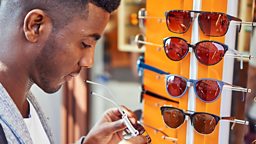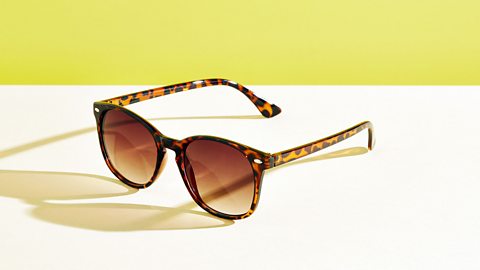Is it worth paying for expensive sunglasses?
Sliced Bread is testing more wonder products suggested by you to see if their claims stand up to scrutiny.
Next up it's sunglasses, and listener Wayne wants to know if expensive ones are really worth the money.
Following laser eye surgery, he no longer needs prescription sunglasses. But on heading to the high street to purchase a pair, he was surprised at the vast range of prices. Do more expensive sunglasses offer better protection for his eyes? And what about a darker tint? Plus, what does 'polarised' mean, and is it important?
Greg Foot sets out to investigate, testing sunglasses ranging in price from £2.50 to more than £100. The results are surprising. But here's what you need to know before splashing out on new sunnies.
1. We should look for sunglasses labelled 'UV 400'
There is visible light, that we can see, but there is also ultraviolet light (a form of electromagnetic radiation), which we can't. UV radiation has a shorter wavelength, which means it has a higher energy, and is damaging to our eyes. "When we buy a pair of sunglasses, ideally what it's going to do is reduce the overall amount of visible light, but also protect us from that UV light," explains James Wolffsohn, Professor of Optometry at Aston University.
Many sunglasses are marked 'UV 400', which means they claim to protect you up to 400 nanometres of UV radiation. "Most of the standards protect us up to 380 nanometres," says James. "Four hundred means you’ve got that extra bit of protection, so overall they should be a more protective lens."

2. Some sunglasses have protection inside the lens, some on the surface
Some glasses have anti-UV materials built in to the actual lenses. With others, the protection lies on the surface of the lens in the form of a coating, which reflects light. However, there is a risk – if any light hits the back of the lens – that UV radiation will be reflected into your eyes. "Some of the newer coatings actually absorb it to make sure that it doesn't then reflect off and do some other damage," says James.
3. Sunglasses that wrap around the face offer better protection
"If you think about how light hits us, it's not just from the front, it's also from the side," says James. "With trends to have smaller lenses, for example, a lot of light can get round, so those that wrap a little bit more round the face are going to be more beneficial, particularly if you do a lot of work outside."
4. Not all sunglasses are deemed safe for driving
Dispensing optician Katherine Howard explains how there's another rating that you might see on the frame of sunglasses: what category they fall into. The category refers to how dark the lenses are – 0 is the lightest, 4 is the darkest.
A category 4 will allow somewhere between 9% and 4% of visible light through to your eyes. This means they're not actually legal for driving. A category 3 lets through somewhere between 18% and 9% which makes them safe for behind the wheel, but not if there’s a tint on the windscreen. "That would then take you over into the category 4 overall, so that's why it would be important to check individual scenarios," explains Katherine.
5. Darker glasses do not mean better protection
Greg and Katherine use a machine to test how much visible light, and how much UV, is getting through lenses on a range of sunglasses. A pair of Ray-Bans with a dark lens and a mirror tint only lets through 10% of the visible light and 0% of the UV. Another pair with more of a sepia lens also gets a UV reading of 0, but these let 35% of visible light through.
As long as the UV protection is there, the tint of the glasses really is just a matter of personal preference. Darker does not mean better.

Are cheaper sunglasses just as good at protecting your eyes?
Greg Foot and optician Katherine Howard test how much UV light cheaper sunglasses block.
6. Polarised lenses do not offer more protection
Polarised lenses cut out horizontal reflections. "When you're driving and its damp and you’ve got the sun reflecting off the road, and you get that sort of bright light, the polarised are designed to cut that out," explains Katherine. Polarisation can also affect the vision of phone and laptop screens. "If you're using them for driving it's best to check you can still see your sat nav," says the optician.
But, polarisation "does not affect the UV protection on there," says Katherine. "It's just whatever people prefer to look through."
7. Some glasses may not deliver on the standards they're displaying
If sunglasses meet the standards that they're meant to then they will carry a CE mark on the glasses frame. (Post-Brexit, this is being replaced with UK CA.) However, some glasses may not deliver on the standards they’re displaying.
Greg and Katherine test two cheap pairs purchased from a market stall, both labelled UV 400. The first pair does indeed block out all UV light. However, the second has a UV number of 57. These are letting through more than half of the UV light falling on the lens.
Katherine explains why this is worrying: "Having the darker tint in there, it's allowing less light through to the pupil. The pupil's then dilating and more of the UV is getting through to the retina and the cornea, which is then harmful and damaging to the eye."
To be sure what you're buying is going to protect your eyes, she would always advise going to your optician. "They are held accountable for what they dispense to you."
8. Paying more might increase durability, but it doesn't mean safer sunglasses
Paying more for your sunglasses might get you glass lenses. "The optics of a glass lens are a lot crisper than a plastics lens," says Katherine. You would also "expect them to be a bit more robust," says James Wolffsohn, with more durable arms. But they won't necessarily offer any more protection to the eyes than middle-of-the-range glasses. As with many products, price doesn't dictate compliance with safety standards. "There can be some quite expensive sunglasses that don’t conform, and likewise some relatively inexpensive ones that do," says James.
A lot of the time you might just be paying through the nose for a designer label. "You can pay a lot more money than perhaps you need to get that brand stamp," says James.
Listen here to find out more about the results from Greg's sunglasses experiment and how listener Wayne responded to his advice.
The information contained in this article was correct at the time of broadcast on 14 July, 2022.

More articles from Radio 4
-
![]()
Can cooking with an air fryer save you money?
Seven things to consider before investing in one
-
![]()
The 'nocebo' effect and how to stop it
How your expectations can transform your life
-
![]()
Why you should take more breaks
Stop for a moment to boost your mood, creativity and focus.
-
![]()
Six things to know before buying running shoes
Greg Foot looks at whether it's worth upgrading your trainers





